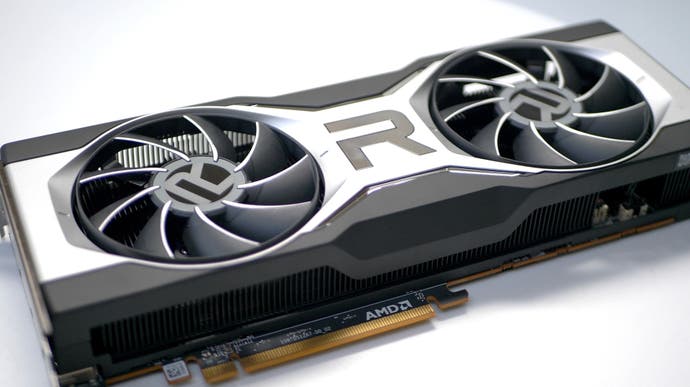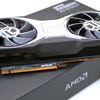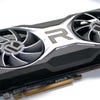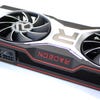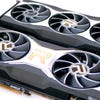AMD Radeon RX 6700 XT review: mid-range powerhouse
A 1440p card with Big Navi's typical strengths - and weaknesses.
So far, AMD's Big Navi graphics cards have lived up their name, giving gamers a true alternative to erstwhile industry leader Nvidia. The RX 6800, 6800 XT and 6900 XT have proved that Team Red can compete at the highest level of the graphics card market, something that hasn't been true for generations. Now though, AMD is expanding its RX 6000 lineup, towards the more mid-range and mainstream cards that will far outsell the 'halo' products at the top of the stack. The first step comes in the form of the RX 6700 XT, a mid-range graphics card aimed at high-end 1440p gaming.
The new $479/£419 card is intended to slot between - and compete with - the $399 GeForce RTX 3060 Ti and $499 RTX 3070, and starts shipping from tomorrow, March 18th. With those price points, we expect to see a card that trades blows with the RTX 3070, offering the same major features, including hardware-accelerated ray tracing and other DirectX 12 Ultimate goodies, while coming in slightly cheaper. It's a recipe that has worked well for AMD in the past, and with both next-gen consoles using the same RDNA2 architecture, the company just needs a standout - yet affordable - PC product to complete the trifecta.
From a hardware perspective, the RX 6700 XT is intriguing. As with past Big Navi designs, the RX 6700 XT uses an Infinity Cache to accelerate its memory subsystems, a salve intended to offer equivalent performance to the high-performance GDDR6X memory in Nvidia's highest-end cards at a fraction of the cost. It works similarly to the L3 cache in AMD's Ryzen processors, storing recently or frequently-requested data locally so that slower data paths needn't be used. Here, the Infinity Cache is 96MB rather than 128MB as we saw in the RX 6800 and up, but AMD still promises exceptional performance - 2.5 times the effective memory bandwidth of a 256-bit bus, delivered with a memory bus that's only 192 bits wide.
As we saw on the RTX 3060 late last month, the bus size means that AMD could equip their card with 6GB or 12GB of GDDR6 memory, and like Nvidia they went with the latter option, giving this card a healthy amount of RAM for its intended performance tier. This card, like its brethren, also supports Smart Access Memory (also known by the more generic term Resizeable BAR), which provides processors direct access to that entire 12GB of memory rather than requiring them to go through a small 256MB I/O buffer. Enabling this tech on supported motherboard and CPU combinations can boost in-game frame-rates by around 15 per cent in some scenarios; we'll show the results of our testing here later on in the review.
| AMD GPU Specs | CUs | Game Clock | VRAM | Mem Interface | TDP | Price |
|---|---|---|---|---|---|---|
| RX 6900 XT | 80 | 2015MHz | 16GB GDDR6 | 256-bit + 128MB IC | 300W | $999 |
| RX 6800 XT | 72 | 2015MHz | 16GB GDDR6 | 256-bit + 128MB IC | 300W | $649 |
| RX 6800 | 60 | 1815MHz | 16GB GDDR6 | 256-bit + 128MB IC | 250W | $579 |
| RX 6700 XT | 40 | 2424MHz | 12GB GDDR6 | 192-bit + 96MB IC | 230W | $479 |
| RX 5700 XT | 40 | 1755MHz | 8GB GDDR6 | 256-bit | 225W | $399 |
| RX 5700 | 36 | 1625MHz | 8GB GDDR6 | 256-bit | 180W | $349 |
| RX 5600 XT | 36 | 1375MHz | 6GB GDDR6 | 192-bit | 150W | $279 |
| RX 5500 XT | 22 | 1717MHz | 8GB GDDR6 | 128-bit | 130W | $199 |
The rest of the specs also make for interesting reading (if you're a massive nerd like me, anyway). The RX 6700 XT's design uses 40 compute units, exactly half the complement of the RX 6900 XT flagship, with the clock speeds dialled way up to compensate for the diminished compute. In game, this card tends to runs between 2400 and 2500MHz, an incredible figure even for a 7nm design - given that the 8nm RTX 3070 is more like 1850 to 1920MHz. These extremely high clock speeds are reflected in the healthy 230W TDP, just 20W below the RX 6800 which uses a much larger 60CU Navi 21 GPU.
In terms of the industrial design, the AMD-designed reference RX 6700 XT is immediately recognisable as a Big Navi card. We've got two axial fans, rather than three on the RX 6800 and 6800 XT, with the Team Rocket 'R' between them. The metal shroud sandwiching the dual-slot design gives the card a certain heft and aura of resilience; I was impressed with the gen-on-gen design improvement when we first saw RX 6000 cards in the flesh and I'm still struck by it today. The card requires one six-pin and one eight-pin power input, with AMD recommending a 550W PSU for comfortable operation.
In terms of I/O, we're looking at the usual assortment - three DisplayPort 1.4b and one HDMI 2.1 port, the latter mainly useful for hooking the card up to any 4K 120Hz or 8K 60Hz displays that you might having lying around. Inside, the card supports AV1 decode, a modern video format that allows for much lower bandwidth at a given quality level; this should allow you to make the most of even relatively slow home broadband and is reportedly rolling out amongst services like Netflix and YouTube.
With the specs and features out of the way, let's briefly run through the setup of our test rig for the benchmarks to follow. You'll see a few new components here if you've not checked out our Radeon 6000 reviews yet, but for those of you that are familiar there are no surprises here. We have a Core i9 10900K locked to a 5GHz all-core frequency and cooled by a 240mm Alpacool Eisbaer Aurora AiO - which keeps the overclocked system at around 75C under full load, and considerably colder than that the rest of the time.
The 10900K is backed by an Asus Maximus 12 Extreme Z490 motherboard and two 8GB sticks of G.Skill Trident Z Royal 3600MHz CL16. Our games are run from a capacious 2TB Samsung 970 Evo Plus NVMe drive provided by British electronics retailer Box. The whole rig is powered by a 850W gold-rated Gamer Storm power supply.
With the introductions concluded, let's get cracking with what we're all here to see: some gaming benchmarks.
AMD Radeon RX 6700 XT Analysis
- Introduction, Hardware and Power Analysis [This Page]
- Doom Eternal, Control, Borderlands 3, Shadow of the Tomb Raider - Game Benchmarks Part 1
- Death Stranding, Far Cry 5, Hitman 2, Assassin's Creed Odyssey - Game Benchmarks Part 2
- Metro Exodus, Dirt Rally 2, Assassin's Creed Unity, Assassin's Creed Valhalla - Game Benchmarks Part 3
- RT Game Benchmarks - Control, Metro Exodus, Battlefield 5
- Resizeable BAR Testing - Watch Dogs Legion, Battlefield 5, Metro Exodus
- AMD Radeon RX 6700 XT - the Digital Foundry verdict
